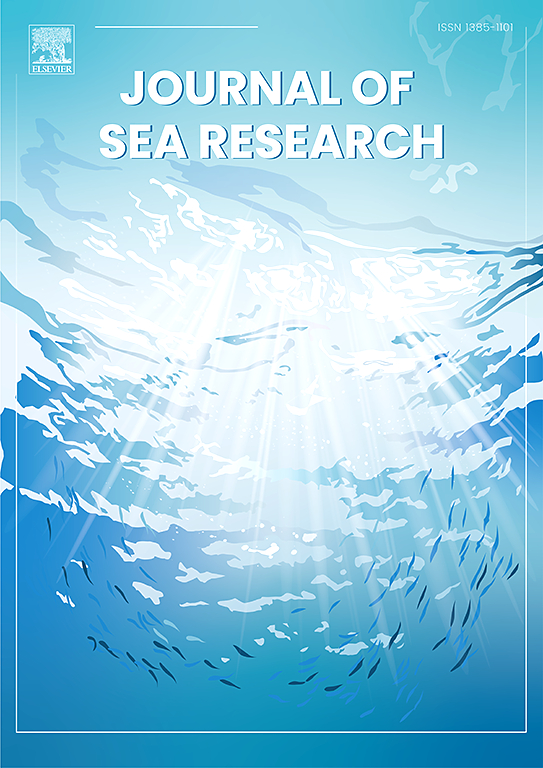Dynamic gradient orientation and multi-scale fusion network for ocean front detection
IF 2.9
4区 地球科学
Q2 MARINE & FRESHWATER BIOLOGY
引用次数: 0
Abstract
As a common and significant physical phenomenon in the global ocean system, ocean fronts have profound impacts on marine environments, ecosystems, and even global climate. Traditional methods for detecting ocean fronts typically use gradient thresholds to distinguish image pixels. When background noise is too high, excessive noise gradients can lead to ambiguous recognition results. Currently, widely used deep learning methods suffer from issues such as a lack of interpretability and insufficient multi-scale feature fusion during the detection process of ocean fronts. To address these problems, this paper proposes a Dynamic Gradient Orientation and Multi-scale Fusion Network, which integrates physical priors with deep learning techniques to achieve higher precision in ocean front detection. Using 30 years (1993–2022) of high-resolution sea surface temperature data for the Northwest Pacific Kuroshio Sea area, we constructed a dynamic gradient orientation angle constraint mechanism (DACM) and a multi-scale gradient fusion mechanism (MSGF). To further enhance the model's interpretability, we improved the detection framework based on you only look once version 11 (YOLOv11), introducing a cross-scale Transformer, dynamic snake convolution, and scale-aware feature fusion modules, making it suitable for ocean front detection. The experimental results show that our method achieved an accuracy and precision of 84.1 % and 79 %, respectively, on the testing set. The ablation experiment verified that the multi-scale fusion mechanism increased the weak front recall rate by 20 %. The results provide a feasible scheme for the deep integration of physical and data-driven ocean front detection, which has certain application value for the analysis of dynamic ocean processes and climate change research.
基于动态梯度定向和多尺度融合网络的海锋探测
海洋锋是全球海洋系统中一种常见而重要的物理现象,对海洋环境、生态系统乃至全球气候都有着深远的影响。传统的海锋检测方法通常使用梯度阈值来区分图像像素。当背景噪声过大时,过大的噪声梯度会导致识别结果模糊。目前广泛使用的深度学习方法在海锋检测过程中存在可解释性不足、多尺度特征融合不足等问题。为了解决这些问题,本文提出了一种将物理先验与深度学习技术相结合的动态梯度定向多尺度融合网络,以提高海锋检测的精度。利用西北太平洋黑潮海域30年(1993-2022)高分辨率海温数据,构建了动态梯度取向角约束机制(DACM)和多尺度梯度融合机制(MSGF)。为了进一步增强模型的可解释性,我们在YOLOv11版本的基础上改进了检测框架,引入了跨尺度Transformer、动态蛇形卷积和尺度感知特征融合模块,使其适合于海前检测。实验结果表明,该方法在测试集上的准确度和精密度分别达到84.1%和79%。消融实验验证了多尺度融合机制使弱前回忆率提高了20%。研究结果为物理海锋探测与数据驱动海锋探测的深度融合提供了可行方案,对海洋动力过程分析和气候变化研究具有一定的应用价值。
本文章由计算机程序翻译,如有差异,请以英文原文为准。
求助全文
约1分钟内获得全文
求助全文
来源期刊

Journal of Sea Research
地学-海洋学
CiteScore
3.20
自引率
5.00%
发文量
86
审稿时长
6-12 weeks
期刊介绍:
The Journal of Sea Research is an international and multidisciplinary periodical on marine research, with an emphasis on the functioning of marine ecosystems in coastal and shelf seas, including intertidal, estuarine and brackish environments. As several subdisciplines add to this aim, manuscripts are welcome from the fields of marine biology, marine chemistry, marine sedimentology and physical oceanography, provided they add to the understanding of ecosystem processes.
 求助内容:
求助内容: 应助结果提醒方式:
应助结果提醒方式:


